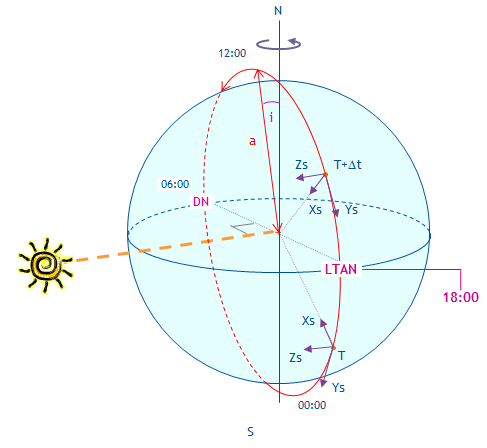Orbital characteristics
It is planned to place Merlin in a near-polar Sun-synchronous orbit (SSO) at about 500 km altitude with a Local Time Ascending Node (LTAN) of 06:00 or 18:00 and a global Earth coverage with a repeat cycle of about 28 days. This choice of orbit is based on the following considerations:
- One of the Merlin mission's scientific requirements is to take measurements on a global scale. The selection of a near-polar SSO ensures that measurements will be able to be taken at high latitudes, including areas of special interest such as Arctic permafrost regions.
- For good Lidar performance, the orbit should be as low as possible in order to obtain a return signal with an appropriate signal-to-noise ratio. The lower limit here is determined by the platform performances, since in low altitudes, atomic oxygen and atmospheric drags can become an issue.
- The choice of LTAN is mainly based on satellite power requirements. The eclipse duration per orbit must be as short as possible to guarantee that the satellite's solar generators can produce enough power around the year for the instrument to operate continuously. The LTAN is also chosen to increase the chance of finding another satellite passenger in the launch range.
- Merlin's orbit is a pseudo-phased orbit, i.e. an orbit which is kept close to a phased orbit with a 28-day repeat cycle. The choice of altitude and station keeping strategy determines on the one hand the spacing between two subsequent orbits and on the other, the periodicity of global coverage. With a 28-day repeat cycle, the spacing between two subsequent orbits is about 100 km at the Equator. For shorter revisit frequencies, this spacing increases and thus the measurement density becomes coarser. The spacing between two subsequent orbits has an impact on the spatial resolution of the measurements and is chosen to meet scientific needs. The revisit period's main influence is on the passes over ground validation sites. Throughout the mission, it will be necessary to regularly validate Merlin data with ground-based measurements. This entails ensuring that there are enough passes over Total Carbon Column Observing Network (TCCON) stations. Merlin's orbit will be maintained to compensate for atmospheric drag and ensure that the needs for good spatial resolution and an appropriate global coverage revisit period are met.

Merlin orbit definition - LTAN: 18:00

Merlin orbit definition - LTAN: 06:00